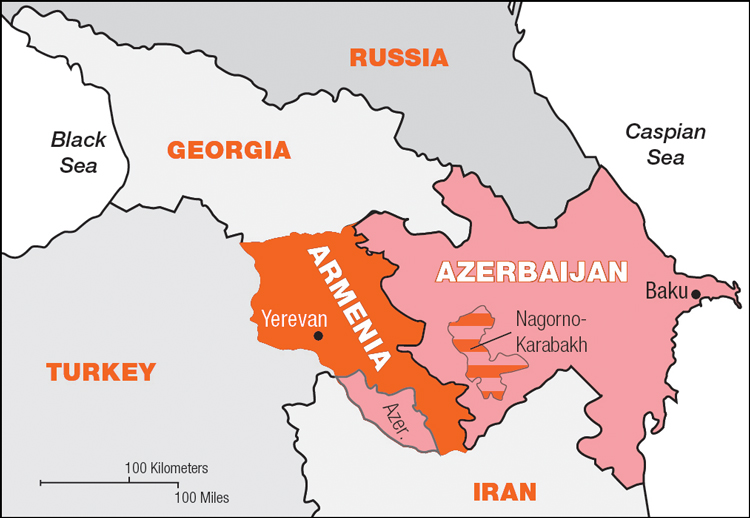Weeks of fighting in the southern Caucasus between the regimes in Azerbaijan and Armenia over control of the territory of Nagorno-Karabakh has taken a big toll on working people throughout the area. With the Turkish government backing Azerbaijan and Moscow allied with Armenia’s rulers, this decadeslong conflict has implications not just in the region, but for broader battles over markets and influence.
Azerbaijan President Ilham Aliyev announced Nov. 8 that his country’s forces had taken the strategic city of Shusha, which sits on a mountaintop overlooking Stepanakert, the capital of Nagorno-Karabakh.
Two days later the governments of Azerbaijan and Armenia announced acceptance of a Moscow-brokered cease-fire. The agreement gives Azerbaijani forces control over all territory conquered in the past six weeks, including Shusha. It calls for some 2,000 Russian forces to deploy in Nagorno-Karabakh, with Ankara kept out of an area Moscow considers part of its “near abroad.”
Nagorno-Karabakh, with a majority Armenian population, lies within Azerbaijan. A previous war for control of the enclave exploded as the Soviet Union was coming apart in the late 1980s and ended in a cease-fire in 1994, with no peace treaty, at the cost of some 30,000 lives. Hundreds of thousands of Azerbaijanis were driven out.
Thousands have been killed in the current fighting. According to the United Nations children’s agency UNICEF, more than 130,000 civilians in the region have been displaced from their homes. Stepanakert was bombarded repeatedly.
Nagorno-Karabakh leader Arayik Harutyunyan told Reuters they had no option but to conclude this deal because of the risk of losing the whole enclave to Azerbaijan.
Azerbaijani forces have far superior military strength than Armenia, with high-tech equipment, including drones purchased from the governments of Turkey and Israel.
Impact of Bolshevik Revolution
This conflict goes back decades. The revolution by workers, soldiers and farmers in Russia in 1917 began to lay the groundwork for how to resolve it.
Workers and peasants across the former czarist prison house of nations made great strides in overcoming national divisions after the Bolshevik Revolution, led by Vladimir Lenin, took power in October 1917. Solidarity was forged by uniting toilers in the fight against exploitation and oppression by landlords and capitalists, and against the predatory aims of intervening imperialist powers. The revolution rapidly spread throughout the Transcaucus region where the class composition of these countries, including Armenia, Azerbaijan and Georgia, was even more peasant-based than in Russia.
Baku Commune
The Bolsheviks won allegiance from industrial workers in Baku, who came from throughout the region. With the formation of a soviet government in April 1918, the Baku Commune was formed. One of its central leaders was Stepan Shaumian, who was elected to the central committee of the Bolshevik Party in 1917. The Baku Commune backed the fight by workers and peasants throughout the Caucasus region in forging unity in struggles against landlord- and capitalist-backed forces.
But many challenges confronted the revolutionary government. Turkish forces invaded the Caucasus in February 1918 seeking to conquer the region. They stirred up nationalist animosities between Azerbaijanis, a Muslim Turkic-speaking people, and Armenians, who are Christians. Clashes ensued.
At the end of July pro-capitalist opponents of the Bolshevik leadership betrayed the Baku Commune. A newly formed counterrevolutionary government rounded up Shaumian and 25 other commune leaders, deported and executed them in September 1918.
Stepanakert is named after Shaumian. Statues of the Bolshevik leader still stand in both Armenia and in Baku.
Two years later, workers and farmers across the region rose up again as the Red Army advanced into the area.
Lenin called for the right to self-determination for oppressed nations and nationalities, an essential part of the Bolsheviks’ program. The Soviet congress in January 1918 established the Russian Soviet Federated Socialist Republic “leaving it to the workers and peasants of each nation to decide independently at their own authoritative congress of soviets whether they wished to participate in the federal government … and on what terms.”
By late 1922, 21 autonomous republics and regions had been established within the RSFSR, and the revolutionary government was collaborating with soviet republics in Armenia, Azerbaijan, Belorussia (Belarus), Georgia and Ukraine to form a voluntary union — the Union of Soviet Socialist Republics.
Special steps were taken by the Bolsheviks to aid the development of the economy, language rights and culture of all the oppressed nationalities. There was a flowering of literacy and art in both Azerbaijan and Armenia. These efforts helped knit together people of the Caucasus region, leading to the formation of a joint Transcaucasian Federation in March 1922.
Lenin followed these developments closely. In a letter sent to the toilers in the Soviet republics in the Caucasus in April 1921, he emphasized, “Communists of the Transcaucasus should be fully alive to the singularity of their position and of the position of their republics, as distinct from the position and conditions of the RSFSR; that they should appreciate the need to refrain from copying our tactics, but thoughtfully vary them in adaptation to the differing concrete conditions.” Nagorno-Karabakh was officially incorporated into Azerbaijan in 1923. But doing so was not the product of a nationalist conflict. Communist leaders of the Azerbaijani soviet republic backed making this enclave part of the Soviet Armenian republic, recounts Ronald Grigor Suny, author of The Baku Commune, 1917-1918, in an interview with Middle East Research and Information Project.
“But because Armenia was so poor,” he said, and had been flooded by Armenian refugees from Turkish massacres in 1915, agreement was reached that it would be best for it to be in Azerbaijan, which had the most advanced economy in the region, including the oil fields of Baku.
But this revolutionary course was reversed in the mid-1920s with the emergence of a privileged bureaucratic layer led by Joseph Stalin that overturned Lenin’s revolutionary policies and reimposed Great Russian chauvinism over these oppressed peoples.
Through the last year of his life, Lenin fought Stalin’s increasing efforts in this direction in the region. This fight is documented in an invaluable book from Pathfinder Press titled Lenin’s Final Fight.


